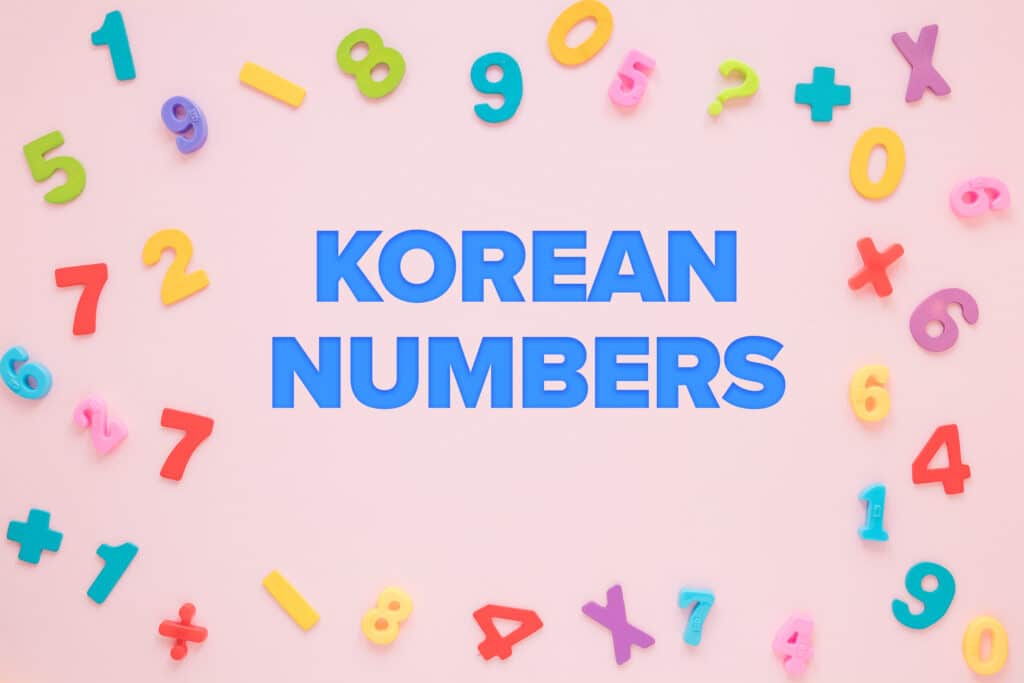Korean Numbers and Counting [Native and Sino-Korean]

Numbers are in everything: addresses, restaurant menus, money, plane tickets, even episodes of your favorite Korean drama.
In this post, I’ll cover both number systems used in Korea—native numbers and Sino-Korean numbers, so you’ll know how and when to use them.
Contents
Download: This blog post is available as a convenient and portable PDF that you can take anywhere. Click here to get a copy. (Download)
Native Korean Numbers
Native Korean numbers are used when counting, talking about age or telling time. Read this post about how to tell time in Korean to perfect that skill.
Native Korean numbers go only as high as 99. Once you need to use a higher number, you will switch to the other Sino-Korean system.
1-10
Here’s how to say one through 10 in Korean:
| Korean numbers | English |
|---|---|
| 하나 (Hana) | one |
| 둘 (Dool) | two |
| 셋 (Set) | three |
| 넷 (Net) | four |
| 다섯 (Dasut) | five |
| 여섯 (Yusut) | six |
| 일곱 (Eelgop) | even |
| 여덟 (Yudul) | eight |
| 아홉 (Ahop) | nine |
| 열 (Yul) | ten |
11-19
Going beyond 10 is really easy. You just use the formula:
10 + X
So for 11, we have 10 + 1 which is 열하나 (yulhana). The numbers 11-19 are known as the yul series because they all start with yul and are suffixed with the numbers from one to nine.
20-90
Next, you need to memorize the tens such as 20, 30 and so on:
| Korean numbers | English |
|---|---|
| 스물 (Seumul) | 20 |
| 서른 (Seoreun) | 30 |
| 마흔 (Maheun) | 40 |
| 쉰 (Shwin) | 50 |
| 예순 (Yesun) | 60 |
| 일흔 (Ilheun) | 70 |
| 여든 (Yeodeun) | 80 |
| 아흔 (Aheun) | 90 |
For building the numbers in between, the method is the same. For example, for the 20 series, you use this formula:
20 + X
So for 21, you take 20, 스물, and one, 하나, and you combine them into 스물하나 (seumulhana).
Here are some more examples:
| Korean numbers | English |
|---|---|
| 여든셋 (Yeodeunset) | 83 |
| 마흔다섯 (Maheundasut) | 45 |
| 아흔여섯 (Aheunyusut) | 96 |
More About Native Korean Numbers
Korean Counters
Counting in Korean requires tags that allow us to identify what types or class of things we’re counting. Whether it’s people, animals, or objects, each requires its own counter.
To actually use these counters, you must use this formula:
Object (What) + Korean Number (How Many) + Counter
Some of these counters are:
개 (gae) is used for counting objects.
For example: 사과 여섯 개 (six apples)
명 (myeong) / 사람 (saram) is used for counting people.
For example: 열 명 (10 people)
마리 (mari) is used for counting animals.
For example: 고양이 여덟 마리 (eight cats)
장 (jang) is used for counting flat objects (eg. sheets of paper).
For example: 종이 일곱 장 (seven sheets of paper)
Special Numbers
1, 2, 3, 4 and 20 are special because they drop their last letter when they’re paired with a counter.
For example, 하나, when paired with a counter 명 isn’t 하나 명 (hana myeong), but rather 한 명 (han myeong).
Here are the rest of the transformations. Notice how they drop the last letter:
하나 (Hana ) → 한 (Han)
둘 (Dool) → 두 (Doo)
셋 (Set) → 세 (Se)
넷 (Net) → 네 (Ne)
스물 (Seumul) → 스무 (Seumu)
Sino-Korean Numbers
Did you know that there’s a second number system in Korean? Yup, Sino-Korean numbers are used to count larger numbers. (More about why this is at the end of the post.)
You can also see Sino-Korean used a lot for dates, times, currency, phone numbers, measurements, addresses and more!
1-10
| Sino-Korean numbers | English |
|---|---|
| 영 (Yeong) or 공 (Gong) | zero |
| 일 (Il) | one |
| 이 (I) | two |
| 삼 (Sam) | three |
| 사 (Sa) | four |
| 오 (O) | five |
| 육 (Yuk) | six |
| 칠 (Chil) | seven |
| 팔 (Pal) | eight |
| 구 (Gu) | nine |
| 십 (Ship) | 10 |
It’s very important that you commit these numbers to memory because they’re your building blocks.
You’re going to be using them for building bigger and bigger numbers.
11-19
This is called the ship series because they all start with 십 (ship):
| Sino-Korean numbers | English |
|---|---|
| 십일 (Shipil) | 11 |
| 십이 (Shipi) | 12 |
| 십삼 (Shipsam) | 13 |
| 십사 (Shipsa) | 14 |
| 십오 (Shipo) | 15 |
| 십육 (Shipnyuk) | 16 |
| 십칠 (Shipchil) | 17 |
| 십팔 (Ship-pal) | 18 |
| 십구 (Shipgu) | 19 |
| 이십 (Iship) | 20 |
As you may have already noticed, the formula for numbers 11-19 is still:
10 + X
So 십, which is the Sino-Korean number for 10, comes first and is then suffixed by the ones digit (X).
That’s why 17 in the Sino-Korean nomenclature is 십칠 (shipchil) following the 10 + X formula.
20-90
You’ll see next that the situation reverses when you deal with 20s, 30s, 40s and so on:
| Sino-Korean numbers | English |
|---|---|
| 이십 (Iship) | 20 |
| 삼십 (Samship) | 30 |
| 사십 (Saship) | 40 |
| 오십 (Oship) | 50 |
| 육십 (Yukship) | 60 |
| 칠십 (Chilship) | 70 |
| 팔십 (Palship) | 80 |
| 구십 (Guship) | 90 |
This time, when you’re dealing with the tens (20-90), the formula is reversed. It becomes:
X + 10
The number 80, for example, becomes 팔십 (palship), where 팔 is the Sino-Korean number for eight and is suffixed by 십, which is 10.
Now that we know how counting by tens works, we can easily work out how the numbers between them like 25, 38 or 49 are written.
You simply add the ones digit at the end.
Let’s designate the ones digit as “Y” this time. So the formula becomes:
X + 10 + Y
We know 20 is 이십 (iship). By adding the five at the end (오), we get 25. Here’s that one and our other examples from above:
| Sino-Korean numbers | English |
|---|---|
| 이십오 (Iship-o) | 25 |
| 삼십팔 (Samship-pal) | 38 |
| 사십구 (Saship-gu) | 49 |
100-10,000
Got all that? Excellent. Let’s move forward and get to the hundreds:
| Sino-Korean numbers | English |
|---|---|
| 백 (Baek) | 100 |
| 이백 (Ibaek) | 200 |
| 삼백 (Sambaek) | 300 |
| 사백 (Sabaek) | 400 |
| 오백 (Obaek) | 500 |
| 육백 (Yukbaek) | 600 |
| 칠백 (Chilbaek) | 700 |
| 팔백 (Palbaek) | 800 |
| 구백 (Gubaek) | 900 |
You’ll notice that the hundreds follow the same form as the ones.
Since three is 삼, 300 is 삼백 (sam-baek) and since seven is 칠, 700 is 칠백 (chil-baek).
For non-round numbers like 367, you just tack on 67 to the tail of 300. So it becomes 삼백육십칠 (sambaek-yukship-chil).
The pattern pretty much holds in the thousands, as well:
| Sino-Korean numbers | English |
|---|---|
| 천 (Cheon) | 1000 |
| 이천 (Icheon) | 2000 |
| 삼천 (Samcheon) | 3000 |
| 사천 (Sacheon) | 4000 |
| 오천 (Ocheon) | 5000 |
| 육천 (Yukcheon) | 6000 |
| 칠천 (Chilcheon) | 7000 |
| 팔천 (Palcheon) | 8000 |
| 구천 (Gucheon) | 9000 |
For non-rounded numbers like 1,367, you just tack on 67 to the tail of 300. So it becomes 천삼백육십칠 (cheon-sambaek-yukship-chil).
10,000+
The number 10,000, 만 (man), is an inflection point in this number system because Koreans count in increments of 10,000.
This is unlike most of the Western world which counts in multiples of 1,000.
For a Westerner—100,000 is 100 multiples of 1,000.
For Koreans—100,000 is 10 multiples of 10,000.
In this number system, 10 million is 천만 (cheonman) because 10 million is 1,000 multiples of 10,000.
Just remember to drop the last four digits of the big number then compose whatever’s left and suffix that number with 만 (man).
Then bring back the four digits that you dropped and compose it as you normally would.
For example, in 127,563 we first drop the last four digits, so only the 12 remains (like 12 multiples of 10,000). So 127,563 is 십이만 칠천오백육십삼.
Here are some more examples:
칠만 팔천이백사십오 — 78,245
삼십칠만 팔천구백오십 — 378,950
To get to even higher numbers, you’ll need to know:
십만 (Ship-man) — 100,000 because it’s 10 x 10,000
백만 (Baek-man) — 1 million because it’s 100 x 10,000
천만 (Cheon-man) — 10 million because it’s 1,000 x 10,000
억 (Eok) — 100 million
조 (Jo) — 1 trillion
How to Say the Date in Korean
In Korea, the date is formatted “Year-Month-Day,” as in 2022 년 4 월 16 일.
년 (Nyeon) — year
월 (Wol) — month
일 (Il) — day
The date above, 2022 년 4 월 16 일, is read as 이천이십이 년 사 월 십육 일.
Here are the months in Korean. They’re simply the first 12 Sino-Korean numbers suffixed by 월 (wol).
| Sino-Korean months | English |
|---|---|
| 1월 (Irwol) | January |
| 2월 (Iwol) | February |
| 3월 (Samwol) | March |
| 4월 (Sawol) | April |
| 5월 (Owol) | May |
| 6월 (Yuwol) | June |
| 7월 (Chirwol) | July |
| 8월 (Parwol) | August |
| 9월 (Guwol) | September |
| 10월 (Shiwol) | October |
| 11월 (Shibirwol) | November |
| 12월 (Shibiwol) | December |
How to Say Phone Numbers in Korean
When saying a phone number, Koreans will say each individual number.
Koreans also use 에 (e) to signify a “dash” between the group of numbers.
The numbers 1, 일 (il), and 2, 이 (i), sound very similar so sometimes 일 (il) is replaced with the native Korean 1하나 (hana) to avoid confusion.
For telephone numbers, 공 (gong) is used for zeroes.
Let’s look at a couple of examples:
공일공에 이삼육사에 팔칠공구 — 010-2364-8709
공구일칠 팔이이에 공공육사 — (0917) 822-0064
Other Uses of the Sino-Korean System
The Sino-Korean number system is used to express any number larger than 100.
This system is also used for currency, addresses, measurements and more.
Here are some examples of Korean counters that use Sino-Korean numbers:
| Sino-Korean words | English |
|---|---|
| 킬로미터 (Kil-lo-mi-teo) | kilometers |
| 미터 (Mi-teo) | meters |
| 리터 (Li-teo) | liters |
| 도 (Doh) | temperature in degrees Celsius |
| 초 (Cho) | seconds |
Why Does Korean Have Two Number Systems?
Korean has two number systems due to the influence of China.
Since China and Korea share a border, they share a lot of cultural and linguistic characteristics. In fact, it’s even said that 60% of the Korean language has Chinese origins.
So there are two number systems: one that is native and one that has Chinese elements.
Here’s a video from our YouTube channel to truly learn the difference between these two systems:
I also suggest you use real Korean media to help. On the language learning program FluentU, for instance, you can watch native video clips and listen to how the different kinds of numbers are used.
FluentU takes authentic videos—like music videos, movie trailers, news and inspiring talks—and turns them into personalized language learning lessons. You can try FluentU for free for 2 weeks. Check out the website or download the iOS app or Android app. P.S. Click here to take advantage of our current sale! (Expires at the end of this month.)
Now that you know Korean numbers, you’ll have the confidence to communicate properly about a variety of things.
Download: This blog post is available as a convenient and portable PDF that you can take anywhere. Click here to get a copy. (Download)
If you enjoyed this post, you're already halfway to having the time of your life learning Korean with FluentU!
FluentU makes it possible to learn with K-pop videos, funny commercials, entertaining web series and more. Just a quick look will give you an idea of the variety of FluentU videos on offer:
FluentU really takes the grunt work out of learning languages, leaving you with nothing but engaging, effective and efficient learning. It's already hand-picked the best videos for you (which are organized by level and topic), so all you have to do is simply choose any video that strikes your fancy to get started.
Each word in the interactive captions comes with a definition, audio, image, example sentences and more.
Access a complete interactive transcript of every video under the Dialogue tab, and easily review words and phrases from the video under Vocab.
You can use FluentU’s unique Quiz Mode to learn the vocabulary and phrases from the video through fun questions.
FluentU keeps track of what you're learning, and tells you exactly when it's time for review, giving you a 100% personalized experience.
Review sessions use video context to help embed the words in your memory.
Start using the FluentU website on your computer or tablet or, better yet, download the FluentU app from the iTunes or Google Play store. Click here to take advantage of our current sale! (Expires at the end of this month.)And One More Thing...












